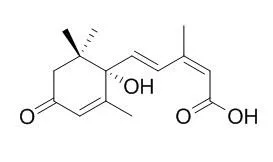| In vitro: |
| Plant Cell Physiol. 2001 Nov;42(11):1265-73. | | Effect of abscisic acid on active oxygen species, antioxidative defence system and oxidative damage in leaves of maize seedlings.[Pubmed: 11726712] | Leaves of maize (Zea mays L.) seedlings were supplied with different concentrations of Abscisic acid (ABA). Its effects on the levels of superoxide radical (O(2)(-)), hydrogen peroxide (H(2)O(2)) and the content of catalytic Fe, the activities of several antioxidative enzymes such as superoxide dismutase (SOD), catalase (CAT), ascorbate peroxidase (APX) and glutathione reductase (GR), the contents of several non-enzymatic antioxidants such as ascorbate (ASC), reduced glutathione (GSH), alpha-tocopherol (alpha-TOC) and carotenoid (CAR), and the degrees of the oxidative damage to the membrane lipids and proteins were examined.
METHODS AND RESULTS:
Treatment with 10 and 100 microM ABA significantly increased the levels of O(2)(-) and H(2)O(2), followed by an increase in activities of SOD, CAT, APX and GR, and the contents of ASC, GSH, alpha-TOC and CAR in a dose- and time-dependent pattern in leaves of maize seedlings. An oxidative damage expressed as lipid peroxidation, protein oxidation, and plasma membrane leakage did not occur except for a slight increase with 100 microM ABA treatment for 24 h. Treatment with 1,000 microM ABA led to a more abundant generation of O(2)(-) and H(2)O(2) and a significant increase in the content of catalytic Fe, which is critical for H(2)O(2)-dependent hydroxyl radical production. The activities of these antioxidative enzymes and the contents of alpha-TOC and CAR were still maintained at a higher level, but no longer further enhanced when compared with the treatment of 100 microM ABA. The contents of ASC and GSH had no changes in leaves treated with 1,000 microM ABA.
CONCLUSIONS:
These results indicate that treatment with low concentrations of ABA (10 to 100 microM) induced an antioxidative defence response against oxidative damage, but a high concentration of ABA (1,000 microM) induced an excessive generation of AOS and led to an oxidative damage in plant cells. |
|
| In vivo: |
| Gene. 2014 Oct 1;549(1):179-85. | | Interaction between abscisic acid receptor PYL3 and protein phosphatase type 2C in response to ABA signaling in maize.[Pubmed: 25091169] | Abscisic acid (ABA) is a ubiquitous hormone that regulates plant growth, development and responses to environmental stresses. In recent researches, pyrabactin resistance 1-like protein (PYL) and protein phosphatase type 2C (PP2C) were identified as the direct receptor and the second component of ABA signaling pathway, respectively. However, a lot of PYL and PP2C members were found in Arabidopsis and several other plants. Some of them were found not to be involved in ABA signaling. Because of the complex diversity of the genome, few documents have been available on the molecular details of the ABA signal perception system in maize.
METHODS AND RESULTS:
In the present study, we conducted bioinformatics analysis to find out the candidates (ZmPYL3 and ZmPP2C16) of the PYL and PP2C members most probably involved in ABA signaling in maize, cloned their encoding genes (ZmPYL3 and ZmPP2C16), verified the interaction between these two proteins in response to exogenous ABA induction by yeast two-hybrid assay and bimolecular fluorescence complementation, and investigated the expression patterns of these two genes under the induction of exogenous ABA by real-time fluorescence quantitative PCR.
CONCLUSIONS:
The results indicated that the ZmPYL3 and ZmPP2C16 proteins interacted in vitro and in vivo in response to the induction of exogenous ABA. The downregulated expression of the ZmPYL3 gene and the upregulated expression of the ZmPP2C16 gene are responsive to the induction of exogenous ABA. The ZmPYL3 and ZmPP2C16 proteins are the most probable members of the receptors and the second components of ABA signaling pathway, respectively. |
|






 Cell. 2018 Jan 11;172(1-2):249-261.e12. doi: 10.1016/j.cell.2017.12.019.IF=36.216(2019)
Cell. 2018 Jan 11;172(1-2):249-261.e12. doi: 10.1016/j.cell.2017.12.019.IF=36.216(2019) Cell Metab. 2020 Mar 3;31(3):534-548.e5. doi: 10.1016/j.cmet.2020.01.002.IF=22.415(2019)
Cell Metab. 2020 Mar 3;31(3):534-548.e5. doi: 10.1016/j.cmet.2020.01.002.IF=22.415(2019) Mol Cell. 2017 Nov 16;68(4):673-685.e6. doi: 10.1016/j.molcel.2017.10.022.IF=14.548(2019)
Mol Cell. 2017 Nov 16;68(4):673-685.e6. doi: 10.1016/j.molcel.2017.10.022.IF=14.548(2019)